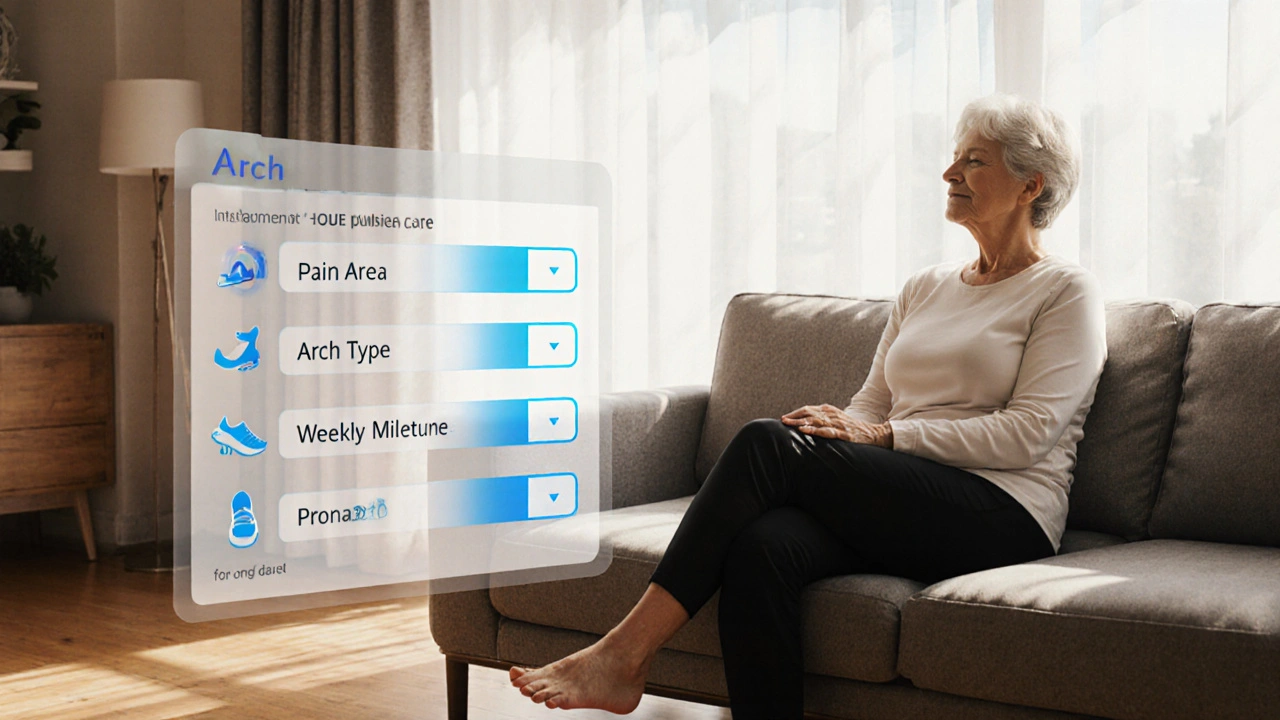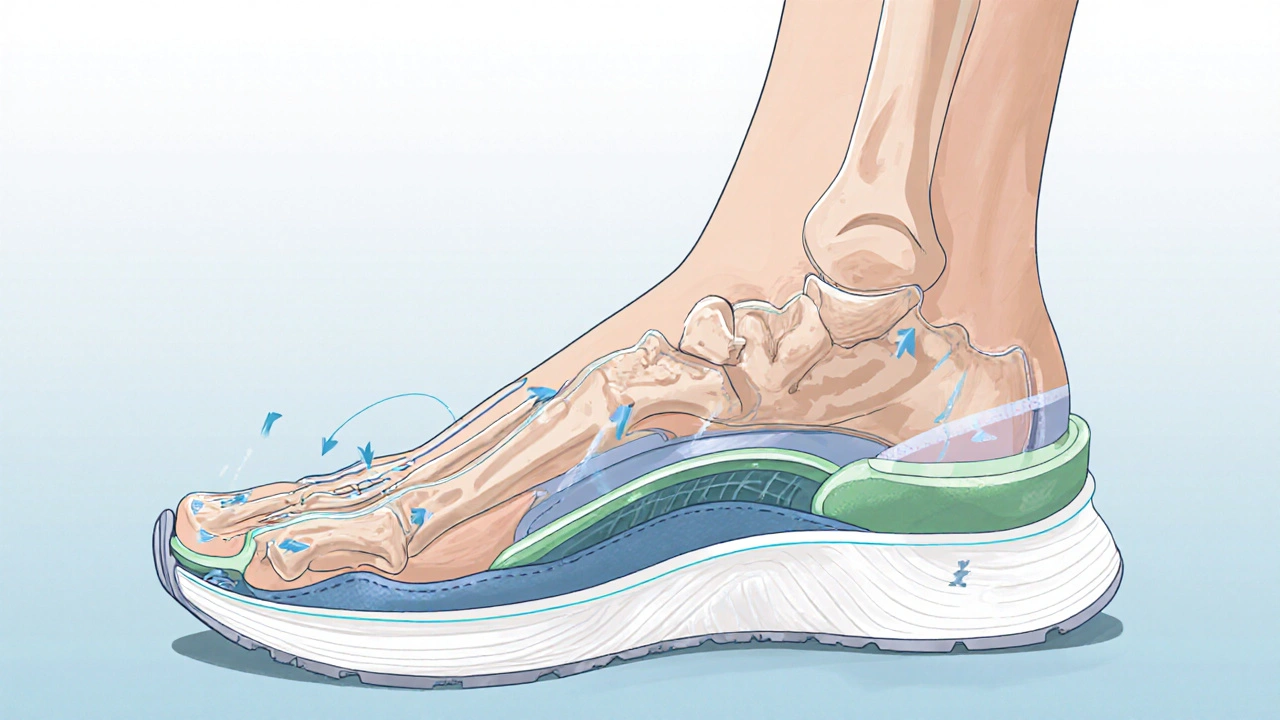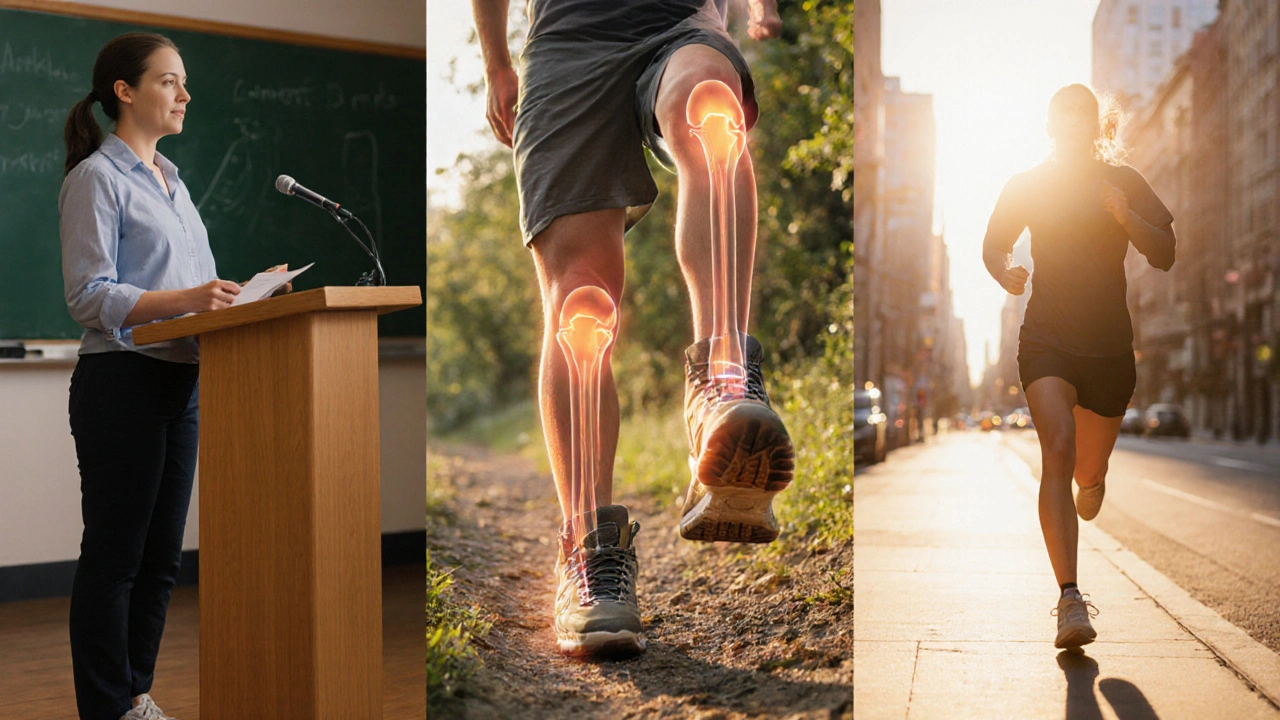Why Proper Footwear Is Crucial for Relieving Joint Pain

Joint Pain Relief Shoe Selector
Recommended Shoe Type
Key Takeaways
- Good shoes can lower pressure on knees, hips and ankles, easing chronic pain.
- Look for arch support, cushioning, and a low heel‑drop to promote natural gait.
- Orthotic insoles are a cheap way to add customized support without buying a new pair.
- Replace shoes every 300‑500 miles or when you notice wear in the midsole.
- Simple checks like heel‑to‑toe drop and pronation type help you pick the right pair faster.
When you think about joint pain, the first thing that comes to mind is usually medication or physio. Yet the shoes on your feet play a massive role in how much stress hits your knees, hips and lower back. Footwear is a protective covering for the foot that influences alignment, shock absorption and weight distribution - all factors that can either aggravate or soothe Joint Pain discomfort arising from inflammation, cartilage loss or mis‑alignment in a joint. The right pair can act like a mini‑physiotherapist, while a bad one may act like a tiny hammer on vulnerable joints.
How Shoes Talk to Your Joints
Every step you take creates a force that travels up the leg. If your shoe’s midsole is too hard, the impact hits the ankle first, then the knee, and finally the hip. Over time, that repeated shock contributes to conditions like Osteoarthritis degenerative joint disease caused by cartilage breakdown. Conversely, a shoe with proper cushioning spreads the load, lowering peak pressure by up to 30% according to a 2023 biomechanical study.
Another hidden player is Gait the pattern of movement of the limbs during locomotion. People who over‑pronate (the foot rolls inward too much) place extra strain on the medial knee. Shoes with built‑in Arch Support a structural element that maintains the foot’s natural arch gently correct this motion, decreasing stress on the knee’s inner compartment.
For those with serious alignment issues, a custom Orthotic Insole removable foot insert designed to correct biomechanical imbalances can make a huge difference. Even a simple over‑the‑counter version can reduce knee pain scores by 1.5 points on the visual analog scale after four weeks of use.

Choosing Shoes That Actually Help
Before you rush to the nearest store, answer these quick questions:
- Do you notice pain after long walks, stairs or standing?
- Which joint hurts most - knee, hip, ankle or lower back?
- Do you have flat feet, high arches, or a neutral arch?
- How many miles do you typically put on a pair of shoes each year?
Based on the answers, you can narrow down the three main shoe categories that work best for joint‑pain relief.
| Type | Key Features | Best For |
|---|---|---|
| Cushioned | Soft midsole, high Shock‑absorption, low heel‑drop | Runners, people with knee osteoarthritis |
| Stability/Support | Firm medial post, arch support, heel counter | Over‑pronators, flat‑footed walkers |
| Orthotic‑Ready | Removable insole, roomy toe box, moderate cushioning | Custom orthotics users, severe biomechanical issues |
When you’re shopping, keep an eye on three measurable specs:
- Heel‑to‑Toe Drop: The height difference between the heel and forefoot. A drop of 4‑6mm is ideal for most joint‑pain sufferers because it encourages a mid‑foot strike without over‑loading the heel.
- Midsole Material: EVA and PU foams are light and absorb impact well. Some brands now use TPU blends that retain cushioning longer.
- Outsole Flex: A flexible rubber outsole lets the foot move naturally, reducing torque on the knee.
Real‑World Stories
Sarah, a 58‑year‑old teacher, started feeling sharp knee pain after a week of standing in her classroom. She switched from flat dress shoes to a pair of cushioned walking shoes with a 5mm drop and added a thin orthotic inset. Within two weeks, her pain dropped from a constant 6/10 to occasional 2/10 after a long day.
Mike, a 42‑year‑old avid hiker, had chronic ankle soreness. He tried a stability boot with a firm medial post. The extra arch support realigned his gait, and after a month his ankle swelling virtually disappeared.
These anecdotes mirror research: a 2022 clinical trial showed that participants who wore supportive footwear for eight weeks reported a 30% reduction in hip‑joint discomfort compared with a control group wearing regular sneakers.
Quick Checklist Before You Buy
- Measure your foot length and width - buy a half‑size larger if you’ll be using orthotics.
- Check the heel‑to‑toe drop; aim for 4‑6mm.
- Ensure there’s a firm arch support or the ability to insert one.
- Look for a cushioned midsole that rebounds after each step.
- Test the shoe’s flexibility by bending the forefoot; it should flex without cracking.
- Walk indoors for at least five minutes; notice any hot spots or pinching.

Common Mistakes to Avoid
1. Buying “fashion‑first” shoes that lack support - they may look great but they’ll jar your joints.
2. Assuming a “one‑size‑fits‑all” approach - foot shape changes with age, weight and activity level.
3. Ignoring wear patterns - if the outsole is worn unevenly, your gait is probably off.
4. Forgetting to replace shoes - even the best pair loses cushioning after ~300 miles.
Next Steps for Pain‑Free Feet
Start by assessing your current shoes. If they’re older than 12 months, have visible creases on the midsole, or you feel a “bouncy” sensation where there should be a smooth roll, it’s time for an upgrade. Visit a specialty store where staff can do a quick gait analysis; many shops offer a free 15‑minute assessment.
If you’re on a budget, consider buying a high‑quality insole and pairing it with a comfortable everyday shoe. The combination often delivers the same pain‑relief benefits as an expensive orthopedic shoe.
Finally, keep a simple log of your pain levels and daily steps. When you notice a trend (e.g., pain spikes after a new pair), you’ll have the data to adjust quickly rather than waiting months for a flare‑up.
Frequently Asked Questions
Can regular running shoes help with knee arthritis?
Yes, as long as they have good cushioning and a low heel‑drop. Look for shoes that absorb impact and keep the knee in a neutral alignment during each stride.
How often should I replace my shoes to protect my joints?
Aim for every 300‑500 miles, or roughly every six to twelve months for daily walkers. When the midsole feels less springy, it’s a sign the cushioning has worn out.
Are there specific shoes for people with hip pain?
Shoes with a modest heel‑drop (4‑6mm) and generous cushioning help reduce the shock that travels up to the hip joint. Stability shoes that control pronation also keep the hip from rotating excessively.
Do I need a custom orthotic if I have flat feet?
A custom orthotic offers the most precise correction, but a good over‑the‑counter arch support can work well for mild flat‑foot issues. Try a prefabricated support first and see if pain improves.
What’s the difference between heel‑drop and heel height?
Heel‑drop measures the height difference between the heel and forefoot of the shoe, while heel height is the absolute height of the heel from the ground. A low drop encourages a more natural gait, whereas a high heel height can shift weight forward and stress the forefoot.

Cayla Orahood
October 5, 2025 AT 19:19Ever notice how the big shoe manufacturers keep dropping “new tech” claims while quietly shipping out the same flat‑sole models? It's like they're part of a covert operation to keep us glued to cheap orthotics so we stay dependent on their endless product cycles. The hidden agenda? Keep your joints miserable enough that you’ll never stop buying. And while they market “cushioning” as a miracle, the midsole compounds are engineered to break down after a few hundred miles, forcing you to replace them before the warranty even kicks in. They even hire influencers who never step outside their climate‑controlled studios to endorse shoes that would literally crumble on a real trail. The result is a never‑ending loop of pain, profit, and propaganda. Stay skeptical, read the fine print, and consider the possibility that the “science” they cite is fabricated. Only by turning the tables can we reclaim control over our own feet and our health.
Matt Cress
October 15, 2025 AT 14:49Oh great, another 5‑minute “shoe selector” that probably crashes on a phone older than my grandma’s flip‑phone. i guess if you cant read the tiny drop numbers you’ll just guess “meh”. Seriously, who needs a PhD in biomechanics to pick a sneaker? just slap on a pair of dad shoes and call it a day – they’re “classic” right?
Jana Winter
October 25, 2025 AT 10:19The article’s prose suffers from a surprising number of grammatical oversights, such as inconsistent capitalization of “Heel‑to‑Toe Drop” and the misuse of semicolons where commas would suffice. Moreover, the phrase “low heel‑drop (4‑6mm) is ideal” is followed by a dangling modifier that creates ambiguity. While the content is informative, these errors undermine its credibility and may distract readers seeking authoritative guidance. A thorough proofread would greatly enhance the piece’s professionalism.
Linda Lavender
November 4, 2025 AT 05:49When one considers the intricate relationship between the biomechanics of the foot and the cascade of forces transmitted through the kinetic chain, it becomes evident that footwear selection is far more consequential than a mere aesthetic choice. The subtle interplay of arch support, midsole density, and heel‑to‑toe drop dictates how each foot strike is absorbed, thereby influencing the cumulative load borne by the knee, hip, and even the lumbar spine. In my experience consulting with athletes across a spectrum of disciplines, I have observed that those who neglect these variables often report a progressive increase in joint discomfort that escalates into chronic pain syndromes. Conversely, individuals who invest in shoes engineered to complement their specific gait patterns frequently experience a marked reduction in inflammation and an improvement in functional mobility. It is not an overstatement to assert that a well‑chosen pair of shoes can act as a preventative orthotic, mitigating the onset of osteoarthritic changes that would otherwise manifest over years of repetitive stress. The scientific literature supports this assertion, with multiple randomized trials demonstrating statistically significant improvements in pain scores among participants using stability or cushioned footwear. Moreover, the technological advancements in foam composites have extended the longevity of cushioning, allowing athletes to maintain optimal shock absorption well beyond the traditional 300‑mile replacement threshold. Nevertheless, it is incumbent upon the consumer to remain vigilant for signs of midsole compression, such as a loss of “spring” during toe‑off, as these are harbingers of diminished protective capacity. Importantly, the customization of orthotic insoles presents an additional layer of personalization, enabling fine‑tuning of medial arch control and pronation correction that off‑the‑shelf models simply cannot match. While the cost of such bespoke solutions may be perceived as prohibitive, the long‑term savings in reduced medical expenses and enhanced quality of life often justify the investment. It is also worth noting that shoe manufacturers are increasingly adopting transparent sizing metrics, including precise heel‑drop measurements, which empower consumers to make data‑driven decisions. As a community of health‑conscious individuals, we should advocate for standardized labeling that demystifies these technical specifications. In practice, I recommend a quarterly audit of one’s footwear, assessing tread wear patterns and midsole integrity, much like one would evaluate the oil level in a vehicle. By treating shoes as an integral component of musculoskeletal health, we elevate the discourse from fashion‑centric chatter to evidence‑based practice. Ultimately, the convergence of scientific insight, personalized fitting, and conscientious maintenance yields a trifecta of benefits: reduced joint pain, enhanced performance, and prolonged footwear lifespan.
Jay Ram
November 14, 2025 AT 01:19If you’ve been limping through your day because of sore knees, just remember that the right shoes can be a game‑changer. Slip into a pair with solid cushioning and feel the difference instantly. Keep moving forward-you’ve got this!